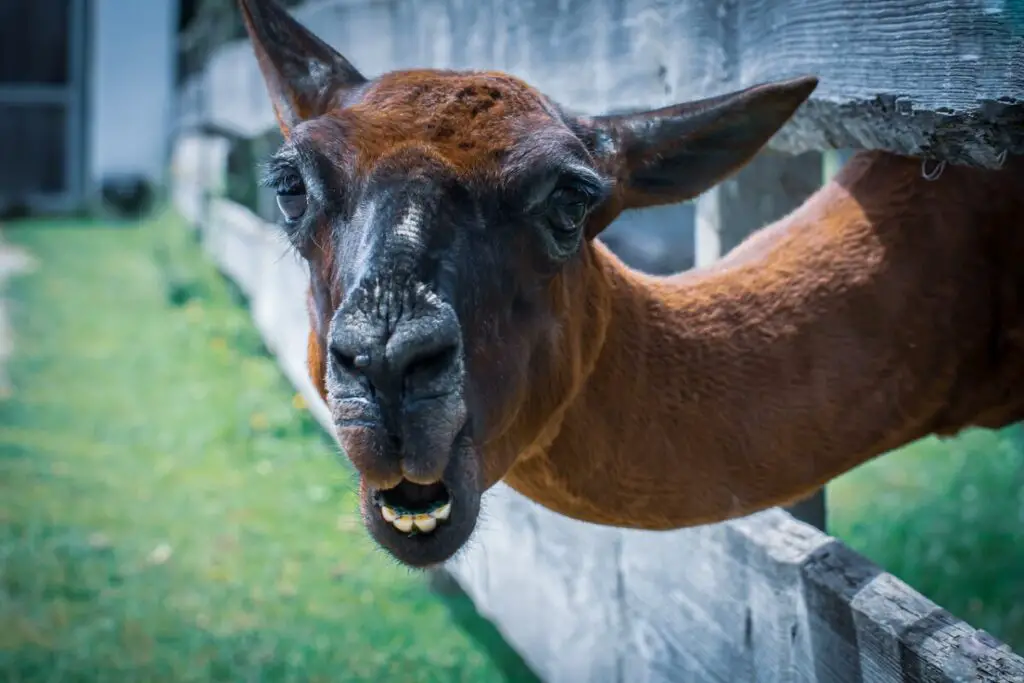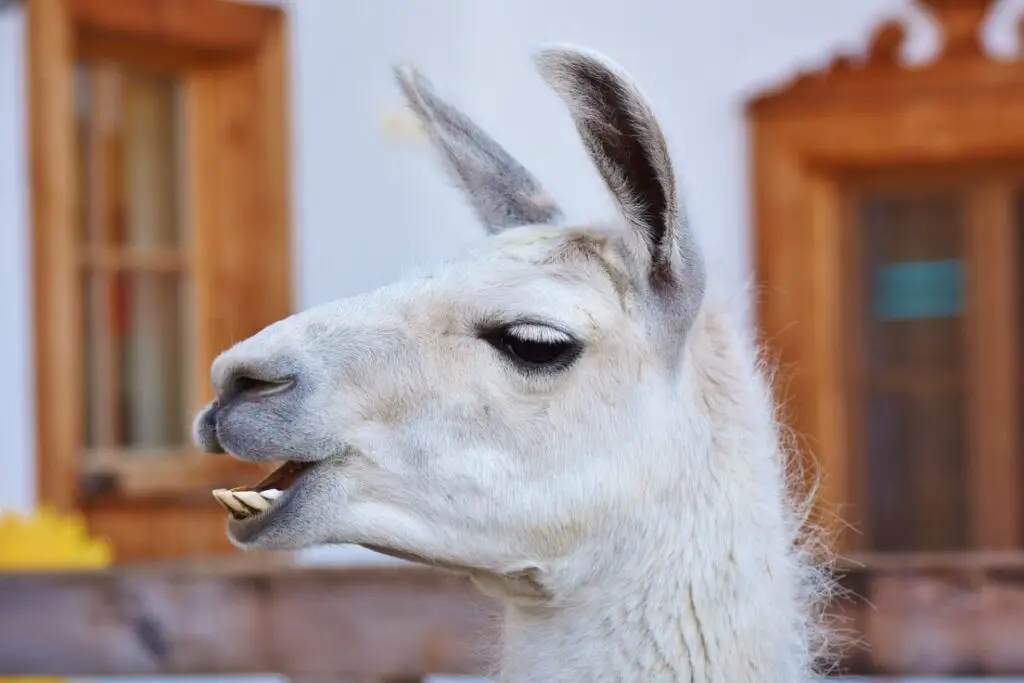Llamas are herbivorous mammals native to South America and have been domesticated for thousands of years. They serve many purposes, including providing wool, transportation, and companionship. As they do not eat meat, it is important to recognize the dietary needs of llamas in order to ensure their health and well-being.
The diet of llamas consists primarily of grasses such as hay or pasture grass; however, other plants may also provide essential nutrients for the animal’s growth and development. To fully meet the needs of these unique creatures, a variety of plant-based foods should be included in their diets. Additionally, minerals and vitamins can help supplement any potential nutrient deficiencies in their natural diet.
Understanding what llamas need nutritionally allows owners to create balanced meals that meet all their dietary needs while keeping them healthy and happy. With proper nutrition, llamas can enjoy long lives full of vitality and energy. The information presented here provides insight into designing nutritious meal plans tailored specifically to each individual animal.
In this article, an overview of the nutritional requirements for llamas will be provided by a nutritionist specializing in these animals.

General Diet Overview
Llamas are herbivores that typically graze on grasses and shrubs, which make up around 80% of their total daily food intake. The remaining 20% consists mainly of hay or other plant-based sources such as legumes, grains, and alfalfa. It’s also important to note that they may require some additional supplements depending on factors such as age, activity level, climate, and region.
In addition to providing essential nutrients, it’s important to give your llama access to fresh clean water each day since hydration is vital for maintaining good health.
Additionally, providing enough space within the enclosure so they can move freely without overcrowding helps promote natural grazing behavior while reducing stress levels significantly. By implementing all these dietary considerations into your llama’s feeding routine you can help them maintain optimal health throughout its lifetime.
Grasses And Plants
Having examined the general diet of llamas, it is now necessary to further explore the principal elements of their nourishment which primarily consists of grasses and plants. In terms of forage consumption, these animals have been observed consuming a variety of native vegetation as well as hay when available.
- Grasses: These are generally found in abundance in pastures and provide an ample source of nutrition for llamas.
- Plants: Depending on the region, specific types of plants may be more readily available than others; examples include clover, alfalfa, thistle, sagebrush and wildflowers.
- Native Vegetation: The local flora can also offer nutrients that no other type of food supply can provide such as cacti pads or prickly pear fruit if present in the area where they live.
- Hay Consumption: During times when fresh grasses and plants are not plentiful due to drought conditions or inclement weather, hay should be made available to supplement their diets with vital minerals vitamins and fibers essential for good health.
Llamas must be provided with adequate amounts of quality feed to sustain them nutritionally throughout all stages of life from infancy until adulthood.
Caretakers should pay special attention to young individuals since their bodies require increased levels of energy during growth periods while older specimens need fewer calories per day but still require sufficient amounts proteins carbohydrates fats and minerals for optimal wellbeing.
Wild Fruits And Vegetables
Llamas are herbivores, relying on vegetation for their sustenance. Wild fruits and vegetables form a major part of the llama diet.
Wild berries can be found growing in abundance across many regions. Edible roots such as carrots, yams and potatoes provide essential nutrition to packs of wild llamas who rely on them for energy. Additionally, wild nuts such as walnuts, hazelnuts and almonds make up an important source of protein needed for growth and development.
Succulent leaves from various plants contain vitamins which aid digestion and maintain healthy body functions. Finally, desert foliage provides vital hydration during hot weather conditions, enabling these animals to survive in harsh environments without access to water sources.
In summary, it is evident that wild fruits and vegetables constitute a significant portion of the llama diet, providing essential nutrients necessary for survival.
Domestic Feeds
Domestic llamas need a diet that provides essential nutrients and energy for maintenance, growth, reproduction, work, and other activities.
They are typically fed hay or pasture as their main source of nutrition. It is important to provide hay with high-quality protein content in order to meet the nutritional needs of domestic llamas. The amount of hay intake should be based on body weight and activity level; adult animals may require up to 1.5% of their total bodyweight per day.
Grains can also be used as supplements to increase nutrient intakes when necessary. Feeding grains alone without adequate amounts of roughage can create digestive problems due to an imbalance between carbohydrates and fiber in llama diets.
Grains should only be provided if recommended by a veterinarian or animal nutritionist who understands the specific requirements of the animal’s lifestyle and condition.
Llamas living on pasture have access to natural vegetation which may supplement their dietary needs depending on quality and availability.
In this case, supplementation with minerals such as calcium and phosphorus may become necessary in order to balance nutrient levels in the overall diet plan. Consulting with an experienced animal nutritionist will help ensure proper feeding for domesticated llamas according to individual circumstances.
By providing proper feed management techniques tailored to each animal’s needs through balanced nutrition from hay, grain, pasture grazing, and/or mineral supplementation, optimal health outcomes can be achieved for domestic llamas.
Minerals And Vitamins
A llama nutritionist knows all too well that minerals and vitamins are essential components in the diet of a healthy llama. Just like people, these sturdy animals need an appropriate balance of both to stay fit, active, and strong. Therefore, it is important for owners to be aware of trace elements needed by their four-legged friends.
Llamas require several specific minerals such as calcium, phosphorus, magnesium, potassium, sodium chloride, sulfur, iron and zinc. Each mineral offers its own unique benefits; however they must be present in proper amounts to ensure optimal health.
For example without ample levels of calcium or phosphorus the bone structure can suffer immensely resulting in weak bones and lameness issues. Similarly low concentrations of other minerals may lead to deficiencies which could affect growth rate and hinder physical performance capabilities. To avoid this issue many recommend regular mineral supplementation through either pasture management or fortified feed products formulated specifically for llamas.
Moreover vitamins are also vital part of any llama’s diet since they provide energy sources necessary for daily activities and help regulate metabolism processes within the body.
The most common vitamins found in llama feeds include Vitamin A, D3 & E but additional vitamin supplementation might be required depending on the animal’s lifestyle combined with environmental factors such as climate conditions etc.
Ultimately understanding what kind of nutrients your lovable pet needs is key when providing them with proper care so make sure to consult with a qualified veterinarian before making any drastic changes to your standard feeding routine!
Water Intake Requirements
The importance of proper water intake for llamas should not be underestimated. Hydration is essential to their overall health and wellbeing, as it enables the body to carry out its metabolic functions efficiently.
While there is no set amount of water that a llama must consume in order to remain healthy, research has suggested that an adult llama will typically drink around 5-7 liters (1¼ – 1½ gallons) per day when given access to ample sources of freshwater. This can vary depending on environmental factors such as temperature, humidity levels, and activity level.
Llamas have evolved with rather efficient drinking habits; they do not need frequent access to fresh water throughout the day but instead prefer longer drinking sessions.
It is important to provide them with clean water at least twice daily and ensure that any standing containers are emptied regularly so that stagnant or contaminated water does not accumulate. If possible, multiple watering points should be made available in different areas of the paddock/enclosure where animals can seek refuge from extreme weather conditions.
It is also advisable for owners to monitor their animal’s behavior periodically in order to identify signs of dehydration or other health issues associated with inadequate hydration levels.
These may include increased heart rate and respiration rate, dry mouth, sunken eyes, skin tenting or lack of energy during exercise routines. By ensuring adequate amounts of fresh drinking water are provided and observing their behaviors closely, owners can help guarantee optimum hydration needs for their llamas.

Potential Health Risks
It is essential for llama owners to understand the possible health risks associated with their animals’ diet, as an unbalanced or inadequate diet can lead to severe consequences. As a case in point, one study observed that when llamas were fed exclusively hay and grain without any other sources of nutrition, they experienced chronic digestive problems such as colic.
| Health Risk | Description |
|---|---|
| Obesity | Excess fat storage due to energy imbalance between food intake and output. |
| Nutrient Deficiency | Lack of nutrient absorption caused by insufficient dietary variety. |
| Digestive Problems | Abdominal pain from improper digestion caused by lack of fiber in the animal’s diet. |
| Poor Immunity | Low resistance to diseases resulting from malnutrition. |
It is important to ensure that all nutritional needs are being met through a balanced diet tailored specifically to each individual llama’s needs, taking into account its age, activity level, general health condition, and other factors.
To prevent long-term health issues related to nutrition, it is recommended that llamas be provided with high quality feed consisting of hay and/or pasture grasses supplemented with grains or other fortified feeds; this should be adjusted based on the season and environmental conditions accordingly.
In addition, minerals (such as salt) must also be provided according to the specific requirements outlined by your veterinarian or local extension office. By following these guidelines, you can minimize potential health risks associated with faulty llama nutrition and create a healthier environment for your animal(s).
Conclusion
Llamas are unique and fascinating creatures due to their diverse diet. They are herbivores that feed on mostly grasses and plants, supplemented by wild fruits and vegetables, domestic feeds as well as minerals and vitamins.
All of these components help to create a balanced diet for the llama while also providing a range of positive health benefits. It is important to note that an adequate water supply must be provided in order for them to remain adequately hydrated throughout the day.
Without proper nutrition, there can be potential health risks such as malnutrition or digestive issues which should be monitored carefully.
In conclusion, it’s clear that llamas have specific dietary needs that must be met in order for them to stay healthy. Their diets need to consist of a variety of fresh greens, grains and other supplements all working together like clockwork gears in order for optimal performance and wellbeing.
Llamas’ nutritional requirements may seem complex at first glance but with careful attention, they can lead long lives full of vitality – like stars twinkling brightly against a night sky.
